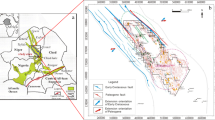Abstract
The Salina Basin historically has been an “exploration desert”—a home of dryholes. Although this basin, which underlies much of north-central Kansas, may never be a prolific source of hydrocarbons, recent research into the maturation and geochemistry of organic matter and oils in Kansas can provide guidelines for a new exploration strategy. The Salina Basin is similar to the oil-productive Forest City Basin in northeastern Kansas in many ways. Both basins originated as a single large basin (i.e., the North Kansas Basin) prior to the rise of the Nemaha Uplift in Late Mississippian-Early Pennsylvanian time. Their Paleozoic stratigraphy thus is similar and the axes of both basins are presently at approximately the same depth. Thermal maturation modeling and available organic-matter maturation data indicate that the lower Paleozoic rocks in the axes of both basins are in the early stages of oil generation. In the Forest City Basin the Ordovician Simpson Group is the deepest known hydrocarbon source-rock—oil-reservoir interval, and by analogy, exploration tests in the Salina Basin, at a minimum, should penetrate through this stratigraphic interval. Ordovician Simpson Group shales in the Forest City Basin are the source rocks for a geochemically distinct oil, which also occurs in Ordovician reservoirs in the extreme southern end of the Salina Basin. To increase the odds of success in an exploration program in the Salina Basin, wildcat wells should be drilled where thermal maturation is greatest. The broad NW–SE-trending basin axis is the most logical area. Exploration tests along this axis in the northern end of the basin may have an extra advantage as organic matter in the Simpson Group may be more thermally mature because of greater burial depth during the Cretaceous. Along the eastern margin of the nearby Central Kansas Uplift and Pratt Anticline, several Paleozoic geologic structures, some of which contain major oil fields, are attributable to tectonic reactivation along the western margin of the Precambrian Central North American Rift System (CNARS). Prospective structural trends in the Paleozoic section of the Salina Basin are anticipated to be associated with this underlying tectonic boundary. The western margin of the CNARS trends NNE–SSW where it passes under the axis of the Salina Basin in northeastern Lincoln and southeastern Mitchell counties. This area is sparsely drilled, with less than two tests per township. If an exploration program can define lower Paleozoic structural closures in this region, these structures may represent the best chance for future petroleum discoveries.
Similar content being viewed by others
Rights and permissions
About this article
Cite this article
Newell, K.D., Hatch, J.R. A Petroleum System for the Salina Basin in Kansas Based on Organic Geochemistry and Geologic Analog. Natural Resources Research 9, 169–200 (2000). https://doi.org/10.1023/A:1010151614263
Issue Date:
DOI: https://doi.org/10.1023/A:1010151614263




